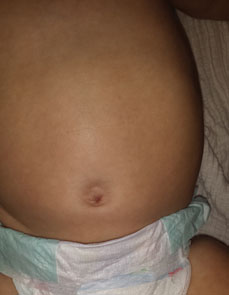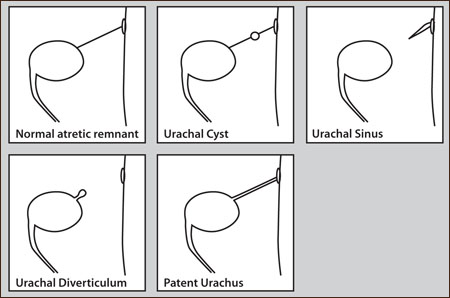A 3-month-old male with persistent ‘belly button bump’
A 3-month-old male presented to pediatric dermatology for evaluation of a persistent “belly button bump.” The child’s umbilical cord detached uneventfully at 2.5 weeks of age. After detachment, however, the umbilicus was noted to intermittently drain clear fluid.
The primary care provider initially applied silver nitrate with an impregnated applicator stick, which did not lead to any improvement. Fearing a local infection had occurred, mupirocin ointment was then applied, and within 3 weeks the parents noted that the draining had stopped.


Physical exam revealed a 3 mm pinkish-brown, moist papule within the umbilicus (Figure 1). Abdominal ultrasound of the area revealed a fistulous connection between the bladder and the umbilicus (Figure 2).
Images: Krakowski AC
Physical exam revealed a 3 mm pinkish-brown, moist papule within the umbilicus (Figure 1). Abdominal ultrasound of the area revealed a fistulous connection between the bladder and the umbilicus (Figure 2).
Diagnosis: (D) Patent urachus
Case discussion
A patent urachus is one of the four types of urachal remnants, along with urachal sinus, urachal cyst, and urachal diverticulum (Figure 3). The urachus is a fetal remnant of the allantois that connects the bladder and the abdominal wall at the level of the umbilicus. In normal development, the urachus becomes an atretic chorda known as the median umbilical fold. Based on a review of 3,400 abdominal ultrasounds, the estimated incidence of asymptomatic urachal remnants is roughly 1.6%.

A patent urachus is one of the four types of urachal remnants, along with urachal sinus, urachal cyst, and urachal diverticulum (Figure 3).
Urachal remnants may be symptomatic or asymptomatic. Symptomatic remnants — either draining or infected — have traditionally been managed surgically. Debate exists, however, about whether surgery is always necessary, especially for asymptomatic urachal remnants, with the most recent literature appearing to favor a nonoperative approach.
In support of expectant management, a study from Chicago found that asymptomatic patients appear to have a high rate of spontaneous resolution, estimated at 87.5%. Interestingly, eight of the 11 “symptomatic” patients also experienced resolution of their urachal remnants after a median interval of 7.5 months. A separate study reported that for children aged younger than 6 months urachal remnants spontaneously resolved in up to 80% of cases.
As surgical excision can have a relatively high complication rate, expectant management is a reasonable recommendation for an infant with an asymptomatic urachal remnant. For a patient with persistence past infancy or with recurrent infections, surgical excision is widely supported. It is important to keep in mind that urachal remnants can rarely present in adulthood as urachal carcinomas. In general, a child who does not have a surgical excision should have repeat imaging to document resolution.
References:
- Ashley RA. J Urol. 2007;178:1615-1618.
- Cuda S. Urology. 2005;66:1320.e7–1320.e9.
- Galati V. J Urol. 2008;180:1824-1826.
For more information:
Emily Osier, MD, is a clinical research fellow in pediatric dermatology at Rady Children’s Hospital, San Diego. She can be reached at 8010 Frost St., Suite 602, San Diego, CA 92123; email: ejosier@gmail.com.
Andrew C. Krakowski, MD, is an attending physician at Rady Children’s Hospital, San Diego.
Disclosure: Osier and Krakowski report no relevant financial disclosures.
